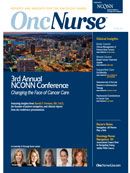Publication
Article
Oncology Nursing News
3rd Annual NCONN Conference: Including insights from Harold P. Freeman, MD, FACS, the founder of patient navigation
Author(s):
The National Coalition of Oncology Nurse Navigators (NCONN) held its 3rd Annual Conference, Changing the Face of Cancer Care, from September 8-10 in San Diego, California.

Harold P. Freeman, MD, FACS
The National Coalition of Oncology Nurse Navigators (NCONN) held its 3rd Annual Conference, Changing the Face of Cancer Care, from September 8-10 in San Diego, California. The conference began with a welcome address from Harold P. Freeman, MD, FACS, who founded patient navigation in Harlem, New York, in 1990.
Freeman has served as president of the American Cancer Society and met 5 US presidents, including 3 whose cancer panels he chaired. He is now the president and founder of the Ralph Lauren Center for Cancer Care and Prevention in New York City, which includes the Harold P. Freeman Patient Navigation Institute. He is an NCONN board adviser and has said of the organization that it “ensures expertise in the field of oncology nurse navigation.”
OncLive Nursing sat down with Freeman at NCONN 2011 and discussed the current and future status of patient navigation. Our conference coverage begins with highlights from our discussion with Freeman and continues with clinical insights from the conference presentations.
Guiding Patients Across the Cancer Continuum
As a surgeon in Harlem in 1990, Freeman was frequently seeing patients with late-stage cancer. He founded patient navigation to eliminate barriers to timely treatment and diagnosis, ensuring that patients with cancer are treated at earlier stages. “Individuals need to be navigated to get the screening tests and once there is a finding, to [get a] diagnosis. Many individuals have abnormal findings on [screening tests such as a] mammogram, but then are lost in the system.”
While the initial focus of patient navigation was primarily on eliminating hurdles to prevention, diagnosis, and treatment, its function has evolved to also include guiding patients through the entire healthcare continuum. Accordingly, Freeman said navigation is moving oncology nursing beyond specialization.
“Fundamentally the function of navigation is to concentrate on the patient’s needs, no matter what they are, and to get away from specialization,” said Freeman. “Whereas formerly nurses were assigned to specific services, such as a nurse working in chemotherapy or a nurse working in radiation treatment, the nurse navigation concept has driven a change in that now we see nurses working [with a single patient] across the treatment continuum.”
All Cancer Patients Today Need Navigators
Freeman started patient navigation to improve cancer care for the medically underserved community, a population that experiences disproportionately high rates of cancer mortality. He believes, however, that all patients with cancer need and should receive navigation.
“Any patient with a serious disease, such as cancer, needs to be navigated. It doesn’t matter how much money you have or whether you have insurance or not—people diagnosed with cancer get lost in the system.”
Still, Freeman said that navigation cannot abandon its roots and must retain its commitment to the medically underserved. “Anyone with cancer needs to be navigated, but the people who need navigation the most are those that don’t have resources, don’t have knowledge, and don’t have insurance.”
The Reach of Patient Navigation
Freeman said the use of patient navigation is widespread and that it is rapidly growing. “My unscientific estimate is more than 2000 medical centers in America now have navigation programs at this point, and it’s growing exponentially.”
He added that starting in 2012, receiving accreditation from the Commission on Cancer (CoC) of the American College of Surgeons will require that facilities have patient navigation programs. CoC certification is highly coveted by cancer care centers, so Freeman projects the new requirement will lead to tremendous growth in patient navigation.
The Sustainability of Patient Navigation
Freeman said that while there is no doubt that patient navigation improves the quality of patient care, its sustainability within the healthcare system hinges on its economic viability. “The fundamental question for the survival and expansion of navigation in the future will be the question of whether it’s cost effective. There is no question that patients are more satisfied when they have navigators.”
Early tests have supported the cost effectiveness of patient navigation, according to Freeman, but he said additional data are needed. Some of the demonstrated cost savings facilitated through patient navigation include decreasing no-show rates and reducing the number of repeated tests through greater coordination within and between medical facilities. Freeman said the ultimate test of cost effectiveness, however, is a measure that will take time to demonstrate: showing that patient navigation leads to increased prevention and earlier diagnosis.
All patients, regardless of their insurance coverage, will be treated if they present at late-stage diagnosis (hospitals cannot legally refuse treatment), explained Freeman. Treatment at these later phases is generally more expensive with more involved procedures and greater pain and symptom management. Therefore, Freeman suggested that data showing that patient navigation increases the rate of prevention and early diagnosis would prove that it reduces the overall cost of healthcare by shifting care away from expensive late-stage treatment. Obtaining these results “will take time, but [they’re] on the way,” noted Freeman.

Latest Conference Coverage

Durvalumab Plus Vaccine Therapy Elicits ‘Encouraging’ DFS in BCG-Unresponsive NMIBC

Iparomlimab/Tuvonralimab Plus Chemo ± Bevacizumab Yields Responses in Recurrent/Metastatic Cervical Cancer

BMS-986253 Plus Nivolumab/Ipilimumab Fails to Boost Responses in Advanced Melanoma After Prior Anti–PD-(L)1 Therapy

Tremelimumab Plus Paclitaxel Generates Responses in Refractory Metastatic Urothelial Cancer
2 Commerce Drive
Cranbury, NJ 08512





